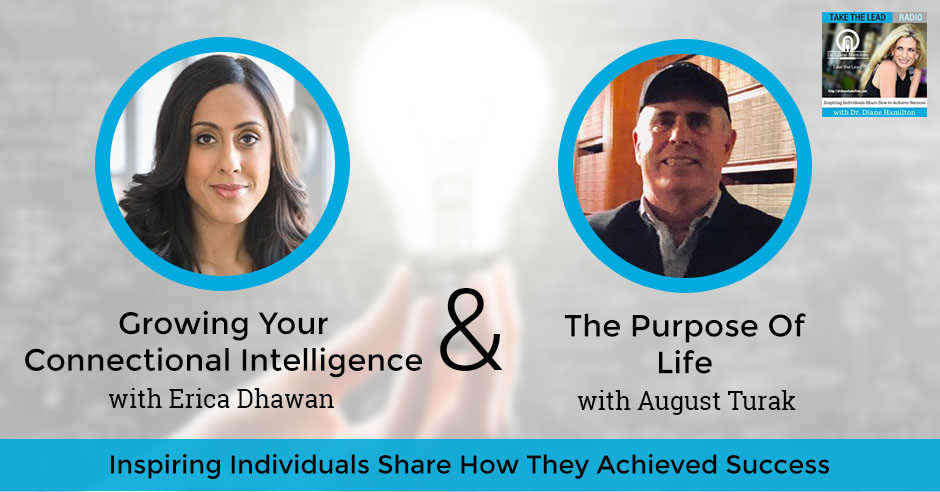
We have Erica Dhawan and August Turak. Erica is the leading authority on Connectional Intelligence and the Founder and CEO of Cotential. August is an award-winning author, speaker, consultant and contributor for Forbes. They both have a lot of interesting work that they deal with and some of it ties into curiosity.
Listen to the podcast here
Growing Your Connectional Intelligence with Erica Dhawan
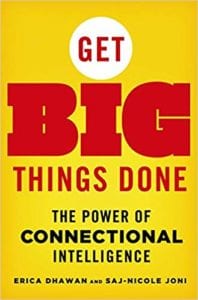
Get Big Things Done: The Power of Connectional Intelligence
I am here with Erica Dhawan, best known as the leading authority on Connectional Intelligence. She’s the Founder and CEO of Cotential, a global consultancy that helps organizations transform by improving collaboration across teams, business units, customers and other stakeholders. She’s also the author of a bestselling book, Get Big Things Done. It’s exciting to have you here.
Thank you, Diane. It’s great to be here.
I’ve looked forward to this. We have a lot of things in common that we research and talk about and speak about and everything else. This is going to be fun. I gave a little bit of background on you. You’ve been named by Thinkers50 as The Oprah of Management Ideas and all the things that you’ve been called as far as an expert. I want to know how you got to this stage in your career. It’s impressive the companies you’re working with. Can you give me a little bit of background of what got you here?
I grew up in a family of Indian immigrants in Pittsburgh, Pennsylvania. I wanted to check off all the boxes of success from my childhood. I went to three Ivy League schools. I worked out of Wall Street at Lehman Brothers and it all came crashing down several years ago when I worked through the Lehman Brothers bankruptcy. During that period, having worked through the great recession, what I saw and asked myself was, “What is success?” What I discovered was this wasn’t a question that I was dealing with and struggling with. It was a question that many of my peers were struggling with, whether they were in private equity or working at a nonprofit or at a large corporate.
That led me on a soul-searching journey and a research journey where I went back to Harvard and MIT where I did graduate work. I stayed on as a researcher and I led a research project that looked at nowadays era of hyperconnectivity where there are many choices, constant change and disruption. How do teams get big things done? Why do certain leaders get big things done and others not? Underneath all of the different examples and case studies that I looked at, what I found was that there was one specific skill that was unique. It was a skill that I now call connectional intelligence. It was this ability for people to be able to work and influence through networks outside of traditional silos to create new sources of value.
Whether it was nonprofitable to tap into unique networks to launch fundraising and unprecedented rates or a scientist within a company able to work across silos in a new and different way that led to a reduction in delays, dysfunction and faster speed to market. Whether it was an individual that was able to take a passion they had to combine it with a set of people that had diverse backgrounds and turn it into a multimillion-dollar, even billion-dollar business using their connections. What I saw was that in nowadays age, we all talk about IQ as basic knowledge. Several years ago, emotional intelligence came to the stage as a key trait. What I found is that in nowadays age, the key critical skill that we all need is connectional intelligence. That’s our ability to maximize the power of all of our networks in our digital age. I ended up writing a book that became a bestseller on this topic. My mission is to create a more connected world now through my keynotes, my training and consulting work.
I’m dealing with curiosity and the impact on performance with that. It deals with many of the things you’re talking about with communication, innovation and engagement kept coming back to me with curiosity. I wrote my dissertation on emotional intelligence which I see the value in measuring all these different factors that connect people or make them be more successful or whatever the main factors are we need to get down to fix all these issues. I love this connectedness. When you were talking about the silo thing, we’ve read the books like The Silo Effect and of the problems out there. When I wrote my book about curiosity, I put a little part in about a hospital in London where they weren’t having a great turnover of their system of the beds and with patients and all that. They were having a hard time being efficient. One of the leaders watched a car racing team put the wheels on and did the whole car in seven seconds. He was thinking, “Why can’t they come to look at our system and see what they thought?” They helped them improve things by 50%. That’s not only thinking outside your department or your silo or whatever, their getting outside their industries. That’s what you’re talking about, getting completely outside of our status quo thinking.
I’ll give you another example. A few years ago, there was a leading executive at Colgate that had a scientific challenge. His team had developed a new fluoride that they were meshing in their toothpaste, but there was a mechanical flow problem and the fluoride was getting stuck in the equipment and it wasn’t meshing well. All the best chemists internally were trying to figure out why and no one could. It was taking months and months of time and costing a lot of money at that point. The executive had the curiosity to say, “Why don’t we ask a different network?” The team ended up posting this challenge on a website called InnoCentive, which is a crowdsourcing community for scientists. They ended up posting it there in an anonymous way. There was no confidentiality issue. Within a few days, a physicist named Ed Melcarek looked at the problem and he wrote in the group that this wasn’t a chemistry problem, it was a physics problem. It was about charged particles. You charge the fluoride one way, the toothpaste the other and instantly the problem for Colgate was solved.
What’s interesting is Colgate learned a few things from this experience. The first thing they learned is that they didn’t even dare to ask the physicist at their own company because they had labeled it as a chemistry problem. The second thing they realized is that physicists that solved the problem would have never been hired by Colgate because he didn’t have the traditional resume. Nowadays age, we not only need curiosity to ask better questions, but we also need the curiosity to design our questions in a way that we engage a broader stakeholder groups. That allows us to discover who the right source is that could contribute to our challenges now. That’s what’s unique in our connected age, our ability to expand the spheres of curiosity, as well as thinking differently about how we can leverage some of the networks we already have at our fingertips. We may not be intentionally using because we’re silo-ing our questions as much as our people.
You’re dealing with this connectional intelligence and I’m sure people hire you to help them to improve in that area. How do you help with connectional intelligence and what’s included in that?
[bctt tweet=”It’s almost impossible to interview someone who is successful who has not failed.” via=”no”]Connectional intelligence is a skill that can be built. We all talk about nature versus nurture, but in this age, there are key ways that you can grow your connectional intelligence. What I focus on are three main things. One is helping individual leaders think differently about how they can create greater value out of the networks they already have. We have a framework that’s available on my site that focuses on what I call the five Cs of connectional intelligence. The first C is curiosity. The others are courage, community, combination, and combustion. All of these skills are skills that you could build and use, whether it’s finding new ways to build community inside and outside your organization or combining different silos or different assets within your company. Having the courage to speak up and take a risk to speak with a different group or engage different stakeholders. The first step is to help individuals grow these skills within themselves, within their teams.
The next step is helping organizations design teams that thrive when it comes to collaboration. In my book, Get Big Things Done, I talk about how there are three types of connectors that you need on your teams. Several years ago, Malcolm Gladwell coined this concept of a connector. In this age, we’re all connectors. We’re over-connected. The job is to understand how we connect intelligently. In my book, I talked about three types of connectors. The first type are the thinkers, the second type are the enablers and the third type are the executors. The thinkers are those that are great at connecting around ideas. They ask great questions. They have high levels of curiosity.
The second type are the enablers. These are the people that are great at connecting and bringing all the right people together. They know how to forge the right structures and the right cohorts. They’re good at combination and community. The third type of connector are executors. These are the people that are great at mobilizing through tasks. Once you have the thinkers who are bringing in new ideas and the enablers who get everyone together around those ideas, executors know how to make it happen. What’s critical for teams is to learn how they make sure they understand the collaboration strengths of their teams. Are there more thinkers? Are there more enablers, executors? How do they design them for diversity so that people are leveraging each other intelligently?
What I find in organizations, for example, thinkers like to hire other thinkers. You have a room or a team of all thinkers who love to talk a lot but have a lot of meetings and then get nothing done. A lot of executors who are analytics or finance individuals, who are task-oriented but may not reach across silos and need those enablers to help forge those connections. The first step is more of the individual five C’s. The second step is designing your teams to master connectional intelligence. The third step is where I worked to help organizations foster and launch collaboration initiatives that transform and incentivize collaboration over time. A great example of this is a large accounting firm I worked with a few years ago that was struggling. They had a lot of new and experienced hired talent that was coming in every year, but it was hard to network in the company.
The way that they get staffed on projects is by knowing people and getting chosen for projects. We saw this challenge and it was inefficient. People were asking for coffee meetings, but they didn’t necessarily lead to people getting staffed on projects. What we did is we brought in the concept of an internal TaskRabbit. It’s a platform where anyone can post a task and anyone can bid to complete that task. We said, “Instead of being chosen by who you know, every single week managers at the company post two to five-hour discrete work tasks.” New hires and experienced hires coming in and want a network can bid to complete those tasks, not only as a way to show their skills but as a way to build trust with leaders across the company outside of their own silo. What we saw is that it increased utilization and the engagement of new hires by up to 16%. What we can all do is to start with asking ourselves, “How can we grow our connectional intelligence as an individual? How can we do it with our teams? How can we institute new practices in our organizations that can help us foster productive collaboration over time?”
Which one of the three types are you of the connectors?
I’m very much a thinker at my strength. I’ve learned and I get this question a lot but you have to flex each one of them based on the role that you’re in. When my book came out, I had to be in executor mode or I had to find executors who could help me. I’m working on my next book. It’s on empathy in a digital age. I am reaching out to my enablers across silos that can help me find the right case studies and examples. I always go back to my thinker cohort when I want to talk about ideas or brainstorm when it comes to research. In many ways, I know my strength, but I also know when I have to flex or who in my network I should reach out to depending on the role that I’m in.

Connectional Intelligence: Empathy is the ability to feel what other people are feeling or putting yourself in somebody else’s shoes.
That’s interesting because you mentioned empathy in a digital age since empathy’s a big part of emotional intelligence. I’ve talked to a lot of people about that, now what we’re going to see with how robots can handle emotional intelligence type of things. I’ve researched some of these big thinkers. I had Jürgen Schmidhuber on my show, the Father of Artificial Intelligence. He was talking about artificial curiosity. Do you think we’ll ever see artificial empathy? Are you worried that robots will be able to do it? Are we thinking that that’s something for humans?
Can you tell me what artificial curiosity is?
There are some groups out there that took Mario Bros. games and had robots play that without external reward. No extrinsic reward is given to them. They kept playing to the next level out of a desire to find out what was next. Even though it wasn’t given a reward-based curiosity, they found their own incentive in this artificial form. That’s pretty much what he was referring to, some of that thing, but I’m not sure exactly what he’s working on. They’re not going to replace how humans think, they do it in a unique way. I interviewed him and I want to go back and listen to it one more time because he was so smart. That’s one of those ones I want to listen to two or three times to know more about what he was working on. His ideas are in three billion or four billion devices throughout the world now. They’re looking at all kinds of ways of creating an artificial form of traits apparently. It’s going to be interesting to see if they’re going to be able to mimic empathy because empathy is the ability to feel what other people are feeling or even put yourself in somebody else’s shoes. If you could mirror that, it seems you could almost come up with an artificial form of it.
It’s one of those things where I would say yes. There’s a way to mimic empathy. Given that definition, I would say I’m definitely not the expert around how AI will transform it. What I will say is that I still do believe in and I’ll give you an example of a time where we cannot rely on the rise of AI to consistently be able to artificially mimic empathy. One of my favorite examples of this is back in 2014. There was a terrorist attack in Sydney, Australia. It was a tragic scenario where people were flooding home from Downtown Sydney to their homes during the day. One of the things that happened during that time is most people were trying to jump into Ubers to try to get home because Uber is a popular car ride-sharing service not only in the US but around the world. The Uber surge pricing went up astronomically because everyone was trying to get home. It was more than twenty times the average price. You think about that moment and you think where the empathy and a moment where algorithms ruled over empathy. We can be in situations where we can try to learn how to mimic empathy through AI. At the end of the day, there will always be mistakes. This is why we need more than data and algorithms in our human connected world.
I’ve had other guests on the show when we talk about this. Even if they can replace certain things with robots, we’re going to always be creating other things that we don’t even know we need or we create a need for something because we want it. I have a lot of guests who don’t get too concerned about what robots can or cannot do for jobs yet. It will be interesting to see what they’re able to mimic, what they’re able to recreate. All this stuff you talk about is interesting to me. How do you measure someone’s connectional intelligence? Is there a way to measure that now?
A few years ago, we launched the Connectional Intelligence Assessment that measures an individual’s CQ. If you’re interested in taking the assessment, you can go to my website. If you sign up for the free report on my main page, you’ll get details for the links to get access to the free assessment. What we focus on is assessing an individual based on the five Cs and their individual ability to use curiosity, combination, community, courage, and combustion for value. For the creation of something new, different, valuable. Where the measurement of connectional intelligence gets exciting is when it’s not just a self-assessment. We work with companies to do a 360 where you’re not just rating yourself, your peers and your direct reports. Your bosses are rating you. That’s where we get a unique cross-section of understanding the influence individuals have on others. At the end of the day, connectional intelligence is more about how do you contribute and influence to the whole versus the value you gain for yourself.
When I was doing my assessment to measure the things that impact curiosity, I created the Curiosity Code Index for that. What you’re talking about reminds me of some of the stuff that I had to do to determine the things that impacted curiosity. Fear was one of the things, which you need the courage to overcome the fear. A lot of our work intersects and it’s interesting to me to see how all these things are becoming more important in the workplace. There’s so much focus on what we need to do in terms of at the personal level for transformation. We saw much focus on soft skills being problematic. Do you think that that’s what led to this, the soft skills revolution that we saw that everybody was getting fired for that?
[bctt tweet=”What connectedness can do is it can help us stay resilient through failure.” via=”no”]We go through ebbs and flows of the importance of soft skills and it’s based on where the markets are and where the national conversation is. That’s why more and more than ever we need more moral leaders who are willing to keep the conversation going on the values that matter most despite the changing times and whatever the national conversation is.
These are all topics I assume you talk about on your podcast. You have a podcast, Masters of Leadership. Is that basically like this show where you deal with leaders and success? Tell me a little bit about your show.
Masters of Leadership is a show that features authors, entrepreneurs, CEOs and their journey of becoming master leaders. What are some of the key pieces of advice that they have? How have they deployed practices? What are the times that they have failed? What did they learn from it? Helping anyone, whether they’re someone new to their career or a senior executive grow as a leader in their organization.
It’s almost impossible to interview someone who is successful who has not failed. It’s something in them that makes them get back up and go at it again, where some people would just give up. What do you think that is? Can we build that quality through connectedness or something else?
What connectedness can do is it can help us stay resilient through failure. When we are able to design a way to engage with peers or share stories, we’re much more quickly able to thrive again, to build our spirits again. I see it every day from Facebook groups that I’m a part of as one community to a live mastermind group that I’m a part of to just being connected to family. What’s unique in this age is the diversity of connections we can create and how that can lead to new exponential value. One of my favorite examples from my book on that is a woman named Jeannie Peeper who had a rare disease called FOP. To give you a sense, there were only two research papers written in the entire twentieth century on this disease.
She scoured from doctor to doctor for many years. She found one doctor who had met a few patients in his lifetime that had this disease. Imagine you know no one with this disease. She wrote to them all and she created the first network of patients with this disease. It grew over time. They started to have barbecues. They turned it into an email newsletter and a Facebook group. This community of patients is a knowledge network for doctors, for medical researchers, for universities to better diagnose this illness and prevent it. They’ve funded the first ever medical research at the University of Pennsylvania for this disease. It all started because one woman was able to have the curiosity to say, “How might I make an influence for generations ahead of me on something that I’ve faced? How could I combine and build a community? How could I have the courage to connect outside of patients and partner with doctors and medical researchers and allowing that all to combust and make something new?” which is now this association and this new lab that they’ve generated for research on this disease.
Even though there are many amazing stories of what you can do now, people are not isolated. I know your work has made people feel more connected and your company’s interesting to me. You’re the CEO of Cotential. A lot of people would probably want to know when you would come to speak and you do all the things you do. If you could share how they can reach you? If they want to get your book or anything else, can you share those links for everybody?
You can find me easily at EricaDhawan.com, which is my website. I do lots of keynotes. Helping people supercharge their collaboration, also learn how to use empathy in a digital world when we don’t have body language as a clutch anymore. The best way to start is to sign up for my free report on my website to get access to the connectional intelligence report and assessment. That’s probably the best place to start. Check out my book, Get Big Things Done, on Amazon.
Erica, thank you for being on the show. It was exciting to talk to you because we have so much in common. It’s fun to hear what you’re doing.
Thank you so much, Diane. It’s great to meet another curious mind.
The Purpose Of Life with August Turak
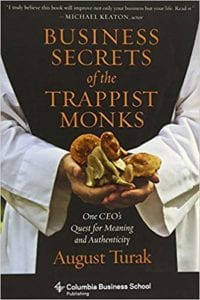
Business Secrets of the Trappist Monks: One CEO’s Quest for Meaning and Authenticity
I am with August Turak who’s an award-winning author, speaker, consultant and contributor for Forbes and BBC. It’s nice to have you here, August.
Thank you so much, Diane. I’m thrilled to be here.
Your background and everything you write about is a little bit different than a lot of people I have on my show. You have several books. You have Business Secrets of the Trappist Monks and you have Brother John: A Monk, A Pilgrim and the Purpose of Life. The monk and the purpose-filled stories are a little bit different than anything I’ve had on my show. I’m looking forward to understanding your background. Where does this focus come from? You do a lot of work with Trappist monks and nonprofits. You have all this interesting background. Can you give us your little backstory there?
I’m originally from Pittsburgh, Pennsylvania. I’m the oldest of eight children. When I was in college, I got interested in the big questions of life. What is the purpose of life? What is the life well-lived? How can I guarantee that I’m not going to waste my life? All that stuff and people always ask me, “All college students always get interested in that, but you’ve spent your whole life on it. Why?” I don’t know. That became a profound interest with me. I dropped out of college to study Zen Buddhism for a few years. Then I was wandering around the country at the time. I was installing carpet for a living because it gave me the flexibility to move around. I was looking for wise people that could teach me about life. I ran into a guy named Louis R. Mobley who was the Founder of the IBM Executive School. He founded it in 1956 and ran it until 1966. I met him because I used to stop at bookstores and asked the bookstore owners.
Back before Barnes & Noble, there were bookstore owners. I’d ask them, “Who are the smartest people in town? Who are the people that you know that could teach me something?” This guy gave me a card and I met this man, Louis R. Mobley. He had a profound, philosophical background that he had used to inform the IBM Executive School when he found it. The results were clear because back in the ‘60s and ‘70s, IBM was the greatest company on Earth. He paraded all the executives and leadership, all that stuff. I was profoundly moved by the guy and how much he knew that I volunteered. He had retired from IBM by that time. He had a consulting business. I said, “Lou, I’ll work for free and help you find clients. Just teach me everything you know.”
[bctt tweet=”The mistake that we all make is thinking that there are many different purposes to life when there is only one.” via=”no”]He said, “I’ll give you one better. I want you to move to my guest house. You can live with my family. Every morning I’ll teach you in my study and afternoon you can hustle us up some clients, but I insist on one thing.” I said, “What’s that?” He says, “I’m paying you for your work.” I moved in with him and I spent a couple of years working with Lou and sucking up like a sponge. I ended up in New York and I ended up working with MTV when MTV started out. I was one of the people who started what’s now the A&E Network. Eventually, I gravitated down here to North Carolina and got into the software business. I talk about all this in my book, Business Secrets of the Trappist Monks. I talk about how we started our own company in 1993 on $2,000 and a business plan, which was my study and my business partner said, “We don’t have a business plan, but we’re smart guys we’ll figure out something to do.” That was our business plan.
All along this line, what was profoundly driving me was not business and was not money. It was knowledge and character development and what we would now call personal growth or personal excellence or some things like that. During the late ‘80s into the ‘90s I started working with college students and I was coaching them on spirituality and on all the stuff. What is a life worth living? Helping them to think about the big questions of life. They talked me into going skydiving with them in 1996. I like to say that I was brave enough to jump out of an airplane but not brave enough to tell them I was too darn old even then to jump out of an airplane. I was in my 40s. I smashed my ankle to smithereens and ended up in the hospital. I started having terrible panic attacks and deep depression. I talk about this as being the beginning of my two-year dark night of the soul. I was confronting my mortality for the first time and I was terrified. I said, “This is only a broken ankle but in a few years, they’re going to walk in here and they’re going to say, “We’re sorry, Mr. Turak. There’s nothing more for you we can do for you.” It brought it home. When I got out of the hospital the panic went away, but the depression was still there.
Another one of my students called and said he was spending the entire summer of 1996 in a Trappist monastery in South Carolina called Mepkin Abbey with the Trappist monks. They had a program called Monastic Guest where you can come down there and wear a robe and become a part-time monk. You get up at 3:00 in the morning and go to church with them and then go out in the fields and work on their farm. Suddenly I blurted out, “I want to come.” Something deep inside of me was telling me that I needed to go there. He arranged for me to come down that weekend. I came back the next weekend and the next weekend and I was blown away by the place. I applied to become a Monastic Guest myself. In the Christmas of 1996, I spent a month there. It was on a cold, rainy, 38-degree Christmas Eve that I encountered Brother John under his umbrella, which became the genesis of my book, Brother John: A Monk, A Pilgrim and the Purpose of Life.
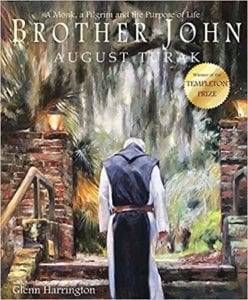
Brother John: A Monk, a Pilgrim and the Purpose of Life
In 2004, I went on to sell my businesses. I’d give you a blow by blow in Business Secrets of the Trappist Monks. I run people through how we started from $2,500. In a few years, we ended up with two multimillion-dollar companies, which we sold to an Israeli company in 2000. Our merged companies were then flipped to BMC software for $150 million in cash. We did extremely well starting with our $2,500 investment because we never took anymore. We never put any more money and we never took any investors on and we never borrowed any money. We bootstrapped the whole thing. I used all the lessons that I learned from the monks to do this. After I was gone from the company by 2004, some of my Duke students said, “You’ve got to enter this contest. There’s this Templeton Foundation. They’ve got this Power of Purpose Essay Contest.” I looked it up and it said, “In 3,500 words or less, answer the question, ‘What is the purpose of life?’”
I’ve never written anything for publication before and this contest was open to previously published material, professional writers. It had been going on for a year. It was international. I had several days before the end of the contest, but I decided to try and write something. I spent a few days getting nowhere and another one of my students said, “Why don’t you write up that story about Brother John that you love telling people all the time?” I said, “That’s not a bad idea.” I sat down. In two days, I whipped up this essay using the story about Brother John from the monastery. I spent a couple more days polishing it. At the last minute, I sent it out and I forgot about it. A few months later, I got a telephone call that my essay, Brother John, had won the $100,000 grand prize. That came the beginning of an entirely new career for me as a writer and an author.
What about the illustrated part? You said there are 22 oil paintings within it now. Where did that come from?
What happened was that Brother John got reprinted in two anthologies, The Best Catholic Writing And The Best Christian Writings. One day, I sat down and I don’t know what struck me. I don’t remember why I did this. I decided to write a white paper for my friends about why I thought these Trappist monks were so darn good at business because they don’t care about business, but everything they touch turns to gold. I write this white paper and the next thing I know, I get a telephone call from an editor at Forbes magazine that had read it and said, “I want to turn it into an article. I want to call it Business Secrets of The Trappist Monks which he did. He made it a four-part article because it started as a white paper and it went viral. That led to an invitation to become a leadership contributor for Forbes, which I am to this day. I got a telephone call from Columbia Business School Publishing saying, “We love that article. We want to turn it into a book.” That’s how Business Secrets of the Trappist Monks came about. I was interviewed about that by the BBC and they liked the interview and the book. They said, “Would you like to become a contributor for us?” and that’s how I became a contributor to the BBC.
As you can see, there’s a happy accident after a happy accident, which is one of the themes of my book. How do you bring these about? Why did these things happen? What happened over the years, I would get a steady drip of letters from people saying that they had encountered, they stumbled on my essay Brother John. It had helped them through the death of a child or a terrible divorce. A couple of years ago, an executive vice president of BB&T Bank drove to my house, a six-hour drive to thank me for writing Brother John. It turned out it was the same thing. He had gone through this horrible divorce. His wife had blindsided. He was madly in love with his wife and she walked in and said, “I’m gone.” He smiled at me and he said, “The fact that I was blindsided, it was probably the problem.”
[bctt tweet=”The more you forget your selfish motivations, the more successful you will become. The less you worry about money, the more money you make.” via=”no”]He ended up almost suicidal. He stumbled on Brother John. I don’t remember where he found it. That led him to the monastery. He spent a month with the monks himself, which turned his life around. On the way out the door, he asked for my address and he drove all the way up here to Raleigh, North Carolina from Charleston, South Carolina to thank me. I said, “That’s it. This is the Lord telling me that I’ve got to get this candle out from underneath this bushel basket and get it out into more people’s hands where it might do some good.” My conundrum was if I got a 3,500-word essay, I’m going to have a preface and introduction. Still, it’s only a 3,500-word essay. How are you going to turn that into a book? What if it was an illustrated book? I stumbled on an artist, his name is Glenn Harrington. I’ve never met the man to this day. He lives somewhere in the woods North of Philadelphia. He got excited. He said, “I want to do this project. I love it. I’ve been to the monastery.” It turned out he’s had a gallery down in Charleston while I visited the monastery. He says, “I want to do this. I’ll do 22 original oil paintings for this book for you.”
This is a huge decision. I called my nephew who works for Scholastic in New York City, the publishing house. I said, “Jamie, this guy, Glenn Harrington wants to do this.” He said, “Is he any good though? I’ll check around for you.” He calls me a couple of days later, he says, “He’s famous. He works with all the top publishers. He’s illustrated 400 books. We pay him $15,000 to do one cover for one of our books and he’s going to do 22 oil paintings for you?” I was so thrilled. The book got released. It’s Brother John: A Monk, A Pilgrim and the Purpose of Life and people love the book and they love the paintings. The people can look at it and the paintings are breathtaking.
I want to know what the purpose of life is. Did you figure it out?
I will share the secret with you and your audience because first of all, the point that I make is the mistake that we all make is thinking that there are many different purposes to life. There’s only one purpose to life. I love the word dogmatic because everybody hates the word dogmatic. I’m dogmatic about this. What I learned from Brother John is the purpose of every human life, whether you realize it or not or whether you agree with me or not, is to be transformed from a selfish person into a selfless person. We all start out as a baby screaming, “Mine.” Some of us do get further along the trajectory than others. The purpose we’re all here to become more selfless. My little motto is it’s in our own self-interest to forget our self-interest. The more successfully you forget your selfish motivations, the more successful you will become.

Connectional Intelligence: One of the ways that great teachers generate curiosity is by exposing us to the inadequacy of our thinking now.
Do we have to give up income to do that?
What I said in my book is the less I worry about money, the more money I make. It’s not a question of giving away everything that you own or any of those. It is a question of putting the interest of other people above your own interest. I’m sponsoring a young girl for the last couple of years. I met her through her father who worked around my farm and he’s a very poor man. His daughter was doing horribly in a public school and being bullied and everything. I’m paying for her private school education with money coming out of my own pocket. I don’t think you have to be a monk and pick up poverty. Let’s look at a corporate situation. I feel qualified to talk about this because I was on the cover of Selling Magazine one time. Every great salesman knows or should know that the more he forgets about his self, forgets about his commissions, forgets about his product and forgets about his quota. Instead, fanatically focuses on serving his customers’ needs, the more sales he makes. Most people think the purpose of becoming a leader is to get myself ahead. I want to get promoted so I want to become a leader. The purpose of leadership is to get other people promoted. My job is to forget about my own career. It’s fanatically focused on getting Diane promoted. The better job I do at getting you promoted, the faster I get promoted.
I do a lot of teaching with students where we talk about servant leadership. How is this different? I don’t know if you’re familiar with Greenleaf and all the servant leadership principles that they teach in colleges. Is that something that you discuss in your books?
I don’t discuss necessarily the servant leadership thing. It’s related, it’s not exactly the same thing to the extent that I understand the servant leadership model. What I’m talking about is a transformational journey from selfishness to selflessness. That it’s a becoming process. All motivation of life itself is a longing for transformation. An acorn doesn’t learn to become an oak. An acorn is longing to be transformed into an oak. A caterpillar doesn’t learn how to be a butterfly. A caterpillar is transformed into a butterfly. It’s called a becoming process. All motivation is a longing for this transformation. For human beings, there are three forms. When a thirsty man drinks, he transforms his condition. When the poor man hits the lottery, he transforms his circumstances.
[bctt tweet=”If you could train yourself to pay attention to anything, you will begin to see patterns.” via=”no”]When Mr. Scrooge wakes up on Christmas morning an utterly new man, he has experienced what is called a transformation of being. We’re all looking for this transformation of being. This selflessness I’m talking about is not something that you do as a duty. It’s something that becomes who you are. The same way with Mr. Scrooge, it’s a change of heart not a change of head. When you have this transformational experience, which is what I described in the Brother John book. Brother John is about this transformational journey from an individual standpoint and the Business Secrets of the Trappist Monks is how we do it collectively in an organization or a corporation. When you have this transformative experience and you become this Mr. Scrooge on Christmas morning and you find the happiness and joy and peace that you’re looking for in life, then you naturally help other people the way you breathe.
You’re talking about motivation before and it brings to mind my research on curiosity because I found that curiosity was the spark to get people motivated. You are a curious person. You wanted to know the meaning of life, the purpose of life. What part does curiosity play in the process of this transformation?
It’s an extremely important part of everything. If you could train yourself to pay attention to anything, you will begin to see patterns. When you start to see a pattern, it locks your attention and yet good concentration follows and that produces curiosity. What are these patterns? Why is this happening? The more curious you get that you bring more attention to it, which brings more concentration, which brings more curiosity. They build on each other one over another. Curiosity is critical. As a matter of fact, I even put it on Facebook a few years ago. I said, “The one thing I can’t forgive you for is a lack of curiosity.” You can forgive anything, but I can’t forgive you when you have no curiosity. One of the ways that great teachers generate curiosity is exposing us to the inadequacy of our thinking now.
Doesn’t perception play a part in all of this, whether you’re curious or not? If you’ve grown up with limited beliefs, how does our perception tie into that?

Connectional Intelligence: Man does not live by bread alone. If you don’t have a sense of higher meaning and purpose in your life, your life is not going to work.
Another concept is noticing, why do certain people notice things that other people don’t notice? I put up a post on my own website. I said, “Everybody’s into mindfulness these days. I’m all for mindfulness, but on the other hand, I’m more into thoughtfulness. Thoughtfulness implies that you’re going to do something with the mindfulness and you’re going to do something for somebody else as a result of it. I remember my old teacher used to say, “The vast majority of pain and suffering that we cause each other is not intentional. It’s caused by thoughtlessness.” Your perception, your awareness it has to start with your awareness. You have to notice that you’re hurting somebody’s feelings or you’re stepping on somebody’s toes or whatever it is. That’s extremely important.
I had Daniel Goleman on the show and he wrote about emotional intelligence first and he’s writing more about mindfulness. You could see how one would cause you to be interested in another. It’s a challenge. People are trying to find the panacea for this, the problems that work. There’s so much lack of engagement. There are soft skills issues or innovation is a problem and all the things keep ending up being a problem. Do we have to become a monk to figure out how to think like this?
That’s exactly why I wrote my book. I have a nonprofit corporation so all of the money that I make from any of my books and for any of my speaking engagements and the money I won from the prize from the Templeton Foundation, all that money goes into my nonprofit. What’s the mission? Our mission is to bring a sense of higher meaning and purpose to a world that from many seem increasingly bereft of meaning and purpose. I gave a speech for graduate students in a business program and I said, “How many of you are going to be leaders or want to be leaders?” They all did. I said, “What’s the number one job of leadership? The number one job of leadership is to provide a vision of meaning and purpose and articulate it for your followers. That’s what leaders do. The number one follower you’re ever going to have in your life is yourself. What is your higher meaning and purpose in your life?” I went on to say that we’re dealing with a leadership crisis and it’s a spiritual crisis of a lack of meaning and purpose.
Andrew Sullivan did an article on the opioid crisis for New York Magazine and I was blown away because he said, “This nation pioneered modern life. Now epic numbers of Americans are killing themselves trump with opioids, trying to escape it. To see this epidemic as simply a pharmaceutical or chemically-addictive problem is to miss something. The despair that currently makes many wants to fly away. Opioids are one of the ways Americans are trying to cope with an inhuman new world where everything is flat, where communication is virtual and where those core elements of human happiness, faith, family, community seem to allude so many. Until we resolve these deeper social, cultural and psychological problems. Until we discover a new meaning or reimagine our old religion or reinvent our way of life, I am afraid the poppy will flourish.”
[bctt tweet=”It’s in our own self-interest to forget our self-interest.” via=”no”]I was blown away by that because I said, “The only thing he’s missing is it’s not just the opioid crisis. We found out that our life expectancy has gone down for the last few years.” In America, for the first time since they started churning it, why? Two reasons, the opioid crisis, and suicide. Suicide is an epidemic of proportions. Suicide is a symptom of meaninglessness. The World Health Organization as I quote in my book said that depression is the number one disease affecting Western civilization. Depression is symptomatic of meaninglessness, purposelessness. We have young men that are living in their parents’ basements until they’re 30 years old playing video games and we have young men that are shooting up high schools and alcoholism and all these things. Everybody thinks that they’re all separate problems and they want to deal with them one-off. They’re all symptomatic of the exact same problem. I saw Carl Jung when I was in college and he said, “Whether God exists or not is a legitimate question. That man needs a god is an incontrovertible fact.” Whether you’re religious or not or believe in God or not, man does not live by bread alone. If you don’t have a sense of higher meaning and purpose in your life, your life is not going to work.
What you’re doing is giving people something to think about based on such an amazing experience you’ve had. No wonder you’ve been successful. A lot of people are going to want to read your books and even to see these illustrations are going to be fascinating. I haven’t seen them yet so I’m looking forward to that. Many people probably want to know how they can reach you and find out more about what you’re doing. Can you share that?
My website is AugustTurak.com. I’m also on Forbes as August Turak and I’m also on Facebook as August Turak. If you google me, you’ll find out a lot more, probably more than you care to know about me.
There is so much great information about you out there. I hope they do google you and I hope they go to your site. Thank you so much for being on the show, August. This was great.
Thank you so much, Diane. I really enjoyed it.
You’re welcome. I’d like to thank Erica and August for being my guests. You can find out more about the Curiosity Code Index and Cracking The Curiosity Code at CuriosityCode.com. I hope you join us for the next episode of Take The Lead Radio.
Important Links:
- Cotential
- Get Big Things Done
- The Silo Effect
- InnoCentive
- Jürgen Schmidhuber – Previous episode
- Masters of Leadership
- EricaDhawan.com
- Get Big Things Done on Amazon
- August Turak
- Business Secrets of the Trappist Monks
- Brother John: A Monk, A Pilgrim and the Purpose of Life
- Mepkin Abbey
- Daniel Goleman – Previous episode
- AugustTurak.com
- August Turak – Forbes
- Facebook – August Turak
- CuriosityCode.com
About Erica Dhawan
 Erica Dhawan is best known as the leading authority on Connectional Intelligence and the Founder & CEO of Cotential, a global consultancy that helps organizations transform by improving collaboration across teams, business units, customers and other stakeholders. Her organization helps companies, leaders, and managers embrace change and improve game-changing performance. She delivers interactive keynotes, live training and online learning on 21st-century leadership, corporate culture, communication, innovation, and engagement. She is the co-author of the bestselling book: Get Big Things Done: The Power of Connectional Intelligence rated #1 on What Corporate America is Reading and host the Masters of Leadership podcast on iTunes.
Erica Dhawan is best known as the leading authority on Connectional Intelligence and the Founder & CEO of Cotential, a global consultancy that helps organizations transform by improving collaboration across teams, business units, customers and other stakeholders. Her organization helps companies, leaders, and managers embrace change and improve game-changing performance. She delivers interactive keynotes, live training and online learning on 21st-century leadership, corporate culture, communication, innovation, and engagement. She is the co-author of the bestselling book: Get Big Things Done: The Power of Connectional Intelligence rated #1 on What Corporate America is Reading and host the Masters of Leadership podcast on iTunes.
About August Turak
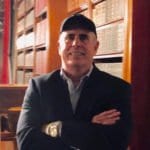 AUGUST TURAK is an award-winning author, speaker, consultant and contributor for Forbes. com and the BBC. He is also the founder of the spiritual and educational nonprofit the Self Knowledge Symposium Foundation (SKSF). August retired as a successful entrepreneur and corporate executive. He attributes much of his success to living and working alongside the Trappist monks of Mepkin Abbey since 1996. As a frequent monastic guest, he learned firsthand from the monks as they grew an incredibly successful portfolio of businesses. His book, Business Secrets of the Trappist Monks, was published in 2013 by Columbia Business School Publishing. When he is not praying and working alongside the Trappist monks of Mepkin Abbey, he works with his nonprofit and lives on a seventy-five-acre farm near Raleigh, North Carolina. His latest book is Brother John, a Monk, a Pilgrim and a purpose of Life.
AUGUST TURAK is an award-winning author, speaker, consultant and contributor for Forbes. com and the BBC. He is also the founder of the spiritual and educational nonprofit the Self Knowledge Symposium Foundation (SKSF). August retired as a successful entrepreneur and corporate executive. He attributes much of his success to living and working alongside the Trappist monks of Mepkin Abbey since 1996. As a frequent monastic guest, he learned firsthand from the monks as they grew an incredibly successful portfolio of businesses. His book, Business Secrets of the Trappist Monks, was published in 2013 by Columbia Business School Publishing. When he is not praying and working alongside the Trappist monks of Mepkin Abbey, he works with his nonprofit and lives on a seventy-five-acre farm near Raleigh, North Carolina. His latest book is Brother John, a Monk, a Pilgrim and a purpose of Life.
Love the show? Subscribe, rate, review, and share!
Join the Take The Lead community today:

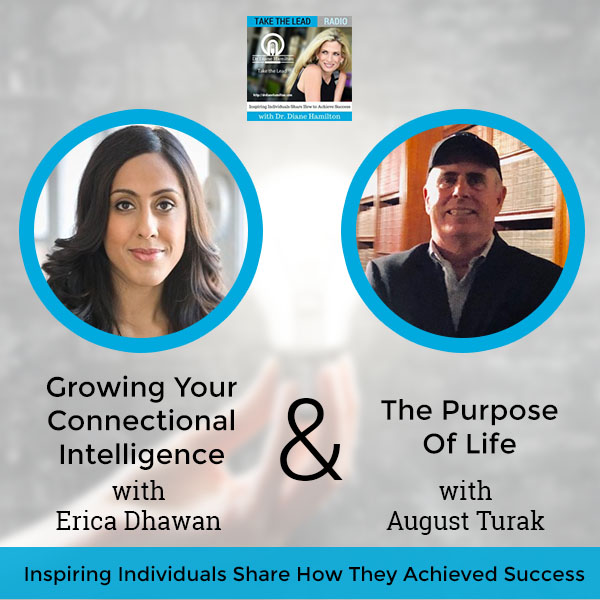

0 Comments